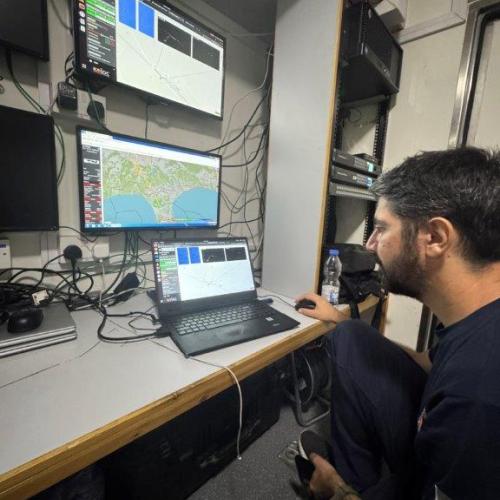
In 2025, wildfires have posed a major challenge for European firefighters. According to the European Forest Fires Information System (EFFIS), 1,990 wildfires (larger than 30 hectares) have been detected since the beginning of the year. Thus, for its second drone use case on not yet well-known ways of using drones and other UAS in crisis management, the COLLARIS2 project has chosen to focus on wildfires, specifically on drone use during the wildfires in Cyprus in July 2025. During these devastating fires, the AIDERS solution provided real-time situational awareness, supporting coordinated emergency response efforts defined by field authorities.
The AIDERS system aims at developing application-specific algorithms and a novel mapping platform that harnesses the large volume of data that first responders are now able to collect through heterogeneous sensors. The solution was first developed by KIOS in 2019, and has been used in multiple full-scale exercises by the Cyprus Civil Defense since then. The main objective of using AIDERS during these fires was to support first responder authorities in the field (Fire Service, Forestry Department, Civil Defence and the Cyprus Police, among others) by monitoring remote or inaccessible areas where firefighters could not operate.
The outcome was improved situational awareness (fire front monitoring, evacuation planning), enabling more informed decision-making and efficient coordination during the wildfire response. The solution has demonstrated a high success rate, particularly in its ability to deliver timely, accurate information that supports effective emergency response.
Find out more about the use case on the COLLARIS2 project website which links to a concise two-page summary.
Virtual Booklet On Drone Use Cases
COLLARIS2 will eventually produce a virtual „booklet” with at least 12 drone use cases, aiming to help overcome the lack of sufficient information about operational use cases for drones. The task is part of the project’s work package 3 - support for the uptake of lessons learnt, lead by the Greek Center of Security Studies, KEMEA. Some elements of the use cases may be included in trial scenarios and training materials.
COLLARIS2 UCPM Exchange of Experts Also Focused on Wildfires
The next COLLARIS2 UCPM Exchange of Experts workshop will also be focused on fighting wildfires. The event at L'Entente de Valabre in France will take place between September 30 and October 2, and will bring together eight experts from various European countries (PL, SE, NL, AT, PT, CZ, BE & HR) at Valabre’s Civil Security Air Resources Simulation Centre.
The experts will share educational knowledge for training courses on the use of drones in all phases of forest firefighting. The main focus is on sharing operational procedures for the use of one or more drones in a degraded operational context. The second step is to find compromises in order to define a common procedure. To this end, different levels will be proposed and the experts will draw up a scenario for each of these phases. Working in teams of two, they will then present their work to the other participants. These scenarios will, then, be shared and included in a summary document.
About COLLARIS2
The EU-funded project COLLARIS2 is the successor to COLLARIS (COLLaborative network on unmanned AeRIal Systems) and focuses on the use of UAS (e.g., drones) in the field of civil protection and disaster management. Building upon the results of the COLLARIS Network, this project aims to continue, expand and further develop the already established international network of crisis management and civil protection practitioners, research institutions and public administration. The members of the network collect and transfer knowledge, exchange experiences, skills, good practices and information on operational procedures for the optimal use of drones in crisis management and rescue missions.
***
Photo Credit: KIOS